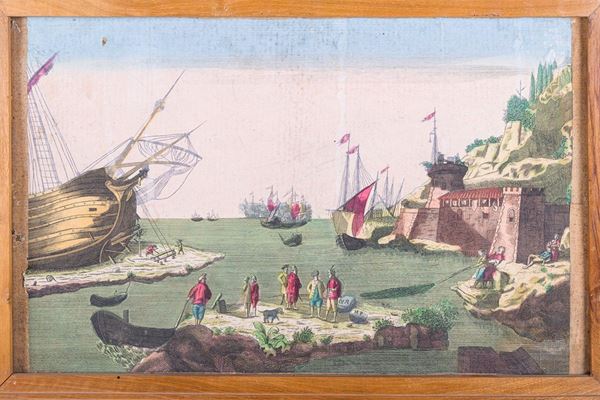222
Optical views of European cities, second half of the 18th century
etching with coeval hand coloring
26 x 42
Georg Baltahasar Probst (1732 - 1801), Optic view of the Berlin Arsenal. Perforated and ready for illuminated viewing.
Georg Balthasar Probst (1732 - 1801), Optical view of Amsterdam from the Amstel river. Not perforated.
Unknown author (second half of the 18th century), printer Daumont Paris, Optical view of the Royal Palace and the Gardens of the Buen Ritiro. Not perforated.
Author unknown (second half of the 18th century), printed in Paris in 1770, Optical view of the Costa de La Lameda from Cadiz. Not perforated.
Author unknown (mid 18th century), Optical view of the port and Place Bourgogne at the port of Bordeaux. Perforated and ready for illuminated viewing.
Remondini family (18th century), Optical view of the Luxembourg Palace from the side of the Giarndini. Perforated and ready for illuminated viewing.
Remondini family (18th century), Optical view of the Palace of the Prince of Liechtenstein in Vienna. Perforated and ready for illuminated viewing.
Unknown author (18th century), Optical view of the Lions Atrium in the ancient Palazzo dei Re Mori di Granata. Not perforated.
Pieter Van der Aa (first half of the 18th century), Aerial view of Piazza San Marco in Venice from the San Gimignano side. Not perforated.
Georg Balthasar Probst (1732 - 1801), View of the Neva in St. Petersburg. Not perforated.
In the 18th century, several well-known printing works in Paris, London, Augusta (Germany) and Bassano del Grappa specialized in the creation of Optical Views. These could be admired through the use of the optical box backlit by a candle which accentuated the perspective and luministic effect. This type of divertissement was highly appreciated in the 18th century in the salons of the bourgeoisie and nobility.
The ten optical views almost certainly belonged to a single owner, as all prepared to be mounted in a viewing roller inside the boîte d'optique (optical box), which was equipped with a crank to scroll through the images.
The ten views are without margins, numbered on the back by hand. On the reverse of the sheet there are some traces of the assembly (strips of colored paper and glue).
Title glued or handwritten on the back.
Some of them show signs of wear, foxing and falls of color. In frames.
€ 600,00
Starting price
Unsold






























